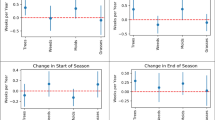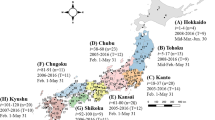Abstract
Common ragweed (Ambrosia artemisiifolia) is an invasive alien species in Europe producing pollen that causes severe allergic disease in susceptible individuals1. Ragweed plants could further invade European land with climate and land-use changes2,3. However, airborne pollen evolution depends not only on plant invasion, but also on pollen production, release and atmospheric dispersion changes. To predict the effect of climate and land-use changes on airborne pollen concentrations, we used two comprehensive modelling frameworks accounting for all these factors under high-end and moderate climate and land-use change scenarios. We estimate that by 2050 airborne ragweed pollen concentrations will be about 4 times higher than they are now, with a range of uncertainty from 2 to 12 largely depending on the seed dispersal rate assumptions. About a third of the airborne pollen increase is due to on-going seed dispersal, irrespective of climate change. The remaining two-thirds are related to climate and land-use changes that will extend ragweed habitat suitability in northern and eastern Europe and increase pollen production in established ragweed areas owing to increasing CO2. Therefore, climate change and ragweed seed dispersal in current and future suitable areas will increase airborne pollen concentrations, which may consequently heighten the incidence and prevalence of ragweed allergy.
This is a preview of subscription content, access via your institution
Access options
Subscribe to this journal
Receive 12 print issues and online access
$209.00 per year
only $17.42 per issue
Buy this article
- Purchase on Springer Link
- Instant access to full article PDF
Prices may be subject to local taxes which are calculated during checkout




Similar content being viewed by others
Change history
10 June 2015
In the version of this Letter originally published online, Dmitry Khvorostyanov's name was incorrectly spelled. This error has been corrected in all versions of the Letter.
References
Kazinczi, G., Beres, I., Pathy, Z. & Novak, R. Common ragweed (Ambrosia artemisiifolia L.): A review with special regards to the results in Hungary: II. Importance and harmful effect, allergy, habitat, allelopathy and beneficial characteristics. Herbologia 9, 93–118 (2008).
Essl, F. et al. Biological Flora of the British Isles: Ambrosia artemisiifolia. J. Ecol. (in the press).
Storkey, J., Stratonovitch, P., Chapman, D. S., Vidotto, F. & Semenov, M. A. A process-based approach to predicting the effect of climate change on the distribution of an invasive allergenic plant in Europe. PLoS ONE 9, e88156 (2014).
Chauvel, B., Dessaint, F., Cardinal-Legrand, C. & Bretagnolle, F. The historical spread of Ambrosia artemisiifolia L. in France from herbarium records. J. Biogeogr. 33, 665–673 (2006).
Bullock, J. et al. Assessing and Controlling the Spread and the Effects of Common Ragweed in Europe Report No. ENV.B2/ETU/2010/0037 (EU Commission, 2012).
Scalera, R., Genovesi, P., Essl, F. & Rabitsch, W. The Impacts of Invasive Alien Species in Europe Report No. 16 (EEA, 2012).
Burbach, G. J. et al. Ragweed sensitization in Europe – GA2LEN study suggests increasing prevalence. Allergy 64, 664–665 (2009).
Vogl, G. et al. Modelling the spread of ragweed: Effects of habitat, climate change and diffusion. Eur. Phys. J. Spec. Top. 161, 167–173 (2008).
Smolik, M. G. et al. Integrating species distribution models and interacting particle systems to predict the spread of an invasive alien plant. J. Biogeogr. 37, 411–422 (2010).
Cunze, S., Leiblein, M. C. & Tackenberg, O. Range expansion of Ambrosia artemisiifolia in Europe is promoted by climate change. ISRN Ecol. 2013, 610126 (2013).
Richter, R., Dullinger, S., Essl, F., Leitner, M. & Vogl, M. How to account for habitat suitability in weed management programmes? Biol. Invasions 15, 657–669 (2013).
Efstathiou, C., Isukapalli, S. & Georgopoulos, P. A mechanistic modeling system for estimating large scale emissions and transport of pollen and co-allergens. Atmos. Environ. 45, 2260–2276 (2011).
Zink, K., Vogel, H., Vogel, B., Magyar, D. & Kottmeier, C. Modeling the dispersion of Ambrosia artemisiifolia L. pollen with the model system COSMO-ART. Int. J. Biometeorol. 56, 669–680 (2012).
Prank, M. et al. An operational model for forecasting ragweed pollen release and dispersion in Europe. Agric. For. Meteorol. 182–183, 43–53 (2014).
Chapman, D. S., Haynes, D., Beal, S., Essl, F. & Bullock, J. Phenology predicts the native and invasive range limits of common ragweed. Glob. Change Biol. 20, 192–202 (2014).
Chuine, I., Garcia de Cortazar Atauri, I., Kramer, K. & Hänninen, H. in Phenology: An Integrative Environmental Science (ed Schwarz, M. D.) 275–293 (Springer, 2013).
Krinner, G. et al. A dynamic global vegetation model for studies of the coupled atmosphere-biosphere system. Glob. Biogeochem. Cycle 19, GB1015 (2005).
Menut, L. et al. CHIMERE 2013: A model for regional atmospheric composition modelling. Geosci. Model Dev. 6, 981–1028 (2013).
Vautard, R. et al. The simulation of European heat waves from an ensemble of regional climate models within the EURO-CORDEX project. Clim. Dynam. 41, 2555–2575 (2013).
Dufresne, J-L. et al. Climate change projections using the IPSL-CM5 Earth System Model: From CMIP3 to CMIP5. Clim. Dynam. 40, 2123–2165 (2013).
Giorgi, F. et al. RegCM4: Model description and preliminary tests over multiple CORDEX domains. Clim. Res. 52, 7–29 (2012).
Collins, W. J. et al. Development and evaluation of an Earth-System model-HadGEM2. Geosci. Model Dev. 4, 1051–1075 (2011).
Moss, R. H. et al. The next generation of scenarios for climate change research and assessment. Nature 463, 747–756 (2010).
Ziska, L. H. & Caulfield, F. A. Rising CO2 and pollen production of common ragweed (Ambrosia artemisiifolia), a known allergy-inducing species: Implications for public health. Aust. J. Plant Physiol. 27, 893–898 (2000).
Reich, P. B. et al. Nitrogen limitation constrains sustainability of ecosystem response to CO2 . Nature 440, 922–925 (2006).
Ziska, L. H. et al. Recent warming by latitude associated with increased length of ragweed pollen season in central North America. Proc. Natl Acad. Sci. USA 108, 4248–4251 (2011).
El Kelish, A. et al. Ragweed (Ambrosia artemisiifolia) pollen allergenicity: SuperSAGE transcriptomic analysis upon elevated CO2 and drought stress. BMC Plant Biol. 14, 176 (2014).
Brewer, C. E. & Oliver, L. R. Confirmation and resistance mechanisms in glyphosate-resistant common ragweed (Ambrosia artemisiifolia) in Arkansas. Weed Sci. 57, 567–573 (2009).
Hurtt, G. C. et al. The underpinnings of land-use history: Three centuries of global gridded land-use transitions, wood harvest activity, and resulting secondary lands. Glob. Change Biol. 12, 1208–1229 (2006).
Jacob, et al. EURO-CORDEX: New high-resolution climate change projections for European impact research. Reg. Environ. Change 14, 563–578 (2014).
Fumanal, B., Chauvel, B. & Bretagnolle, F. Estimation of pollen and seed production of common ragweed in France. Ann. Agric. Environ. Med. 14, 233–236 (2007).
Acknowledgements
This study was carried out within the ‘Atopic diseases in changing climate, land use and air quality’ (ATOPICA) FP7 Project, under grant agreement #282687. We are grateful to all pollen data providers from the European Aeroallergen Network (https://ean.polleninfo.eu), the French aerobiology network RNSA (http://www.pollens.fr), ARPA-Veneto and ARPA-FVG (Italy). We are also grateful to A. Cvitković and N. Periš from the Croatian Institute of Public Health (counties of Brodsko-Posavska and Splitsko-Dalmatinska, respectively), B. Stjepanović from the Department of Environmental Protection and Health Ecology Institute of Public Health ‘Andrija Štampar’ (Zagreb) and R. Peternel from the Associate-degree college of Velika Gorica, for providing pollen measurements. We thank J-P. Besancenot for critical reading of the manuscript.
Author information
Authors and Affiliations
Contributions
L.H-L. led the study, designed and conducted the CHIMERE experiments. L.L. and F.S. developed and conducted the parallel experiments with RegCM. D.K. developed the pollen version of CHIMERE, and N.V. developed the pollen production module in ORCHIDEE. R.V. coordinated the pollen modelling ATOPICA work package (WP2) and M.M.E. coordinated the ATOPICA project. J.S. and M.A.S. provided the methodology and climate habitat suitability results. I.C. provided the PMP phenology model and contributed to the development of the ragweed phenological model. F.E. provided advice and helped in designing the experiments. M.T. provided the French monitoring data and advice during the study. A.C. provided advice and contributed to the WRF EURO-CORDEX simulations production and analysis. A.S. provided the initial version of the phenology modelling approach. All authors contributed to the article writing.
Corresponding authors
Ethics declarations
Competing interests
The authors declare no competing financial interests.
Supplementary information
Rights and permissions
About this article
Cite this article
Hamaoui-Laguel, L., Vautard, R., Liu, L. et al. Effects of climate change and seed dispersal on airborne ragweed pollen loads in Europe. Nature Clim Change 5, 766–771 (2015). https://doi.org/10.1038/nclimate2652
Received:
Accepted:
Published:
Issue Date:
DOI: https://doi.org/10.1038/nclimate2652
This article is cited by
-
Distinctive foliar features and volatile profiles in three Ambrosia species (Asteraceae)
Planta (2023)
-
Projected climate-driven changes in pollen emission season length and magnitude over the continental United States
Nature Communications (2022)
-
The significance of biomass allocation to population growth of the invasive species Ambrosia artemisiifolia and Ambrosia trifida with different densities
BMC Ecology and Evolution (2021)
-
Increased duration of pollen and mold exposure are linked to climate change
Scientific Reports (2021)
-
A systematic review of the effects of temperature and precipitation on pollen concentrations and season timing, and implications for human health
International Journal of Biometeorology (2021)



